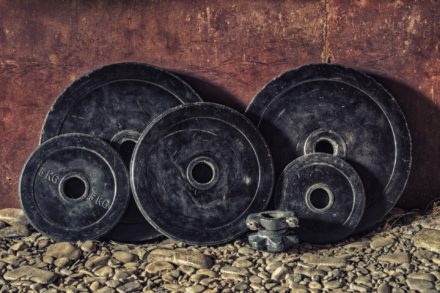
Update 2 — September 22, 2011: I have recently started doing Crossfit workouts again. I switched to conventional strength training (see update below) for a while, but have now returned to Crossfit’s more intensive calisthenics workouts. I’m finding that cycling between the two is beneficial.
Update: this post is from 2009. For my more recent thoughts on fitness, see this April 2011 post.
About a year ago, my pal Danny, a trainer in New York City, introduced me to Crossfit, a fitness regimen that has changed the way I think about physical training.
What is Crossfit?
Crossfit is a fitness philosophy that incorporates calisthenics, running, jumping, and weight lifting done at high intensity, usually for short periods of time.
The Crossfit Wikipedia page has a good overview. You can find more info on the official Crossfit site, on the What is Crossfit? page.
I also like this description, also from the Crossfit site. It’s called “World-Class Fitness in 100 Words:
Eat meat and vegetables, nuts and seeds, some fruit, little starch and no sugar. Keep intake to levels that will support exercise but not body fat. Practice and train major lifts: Deadlift, clean, squat, presses, C&J, and snatch. Similarly, master the basics of gymnastics: pull-ups, dips, rope climb, push-ups, sit-ups, presses to handstand, pirouettes, flips, splits, and holds. Bike, run, swim, row, etc, hard and fast. Five or six days per week mix these elements in as many combinations and patterns as creativity will allow. Routine is the enemy. Keep workouts short and intense. Regularly learn and play new sports.
~Greg Glassman
Why I like Crossfit
I really like Crossfit workouts. Here’s why:
- Simplicity — as you’ll see in the sample workouts below, a typical training session is quite straightforward. There’s a focus on calisthenics — exercises that involve moving your own body weight, like push-ups, pull-ups, sit ups, and squats.
A word about pull-ups: Crossfit philosophy advocates kipping pull-ups, which are different than standard, dead-hang pull-ups. In a kipping pull-up, you swing your body and drive your hips upward, using your entire body to raise your chin over the bar. This can be difficult to learn, but the idea is that you can do more pull-ups in less time this way, and thus work your muscles more intensely than you can with dead-hang pull-ups. A couple of good kipping tutorials can be found on YouTube here and here.
- Intensity — Many Crossfit workouts last 20 minutes or less. But you push yourself as hard as you can for the given amount of time. The workouts, which resemble interval training, tend to be short and punishing (with occasional long runs and rowing workouts thrown in for good measure). My sense is that this produces better fitness gains than the typical gym route: a run at a moderate pace followed by some resistance training. This recent New York Times blog post contains more info on the benefits of interval training.
- Everything is measurable — nearly every workout is done for time. So while workouts are highly variable, when you do repeat a given workout, you can check to see what your previous time was and try to beat it.
- Variety — Crossfit is cross-training to the extreme. The notion is that every workout should challenge your body in a different way. I’ve never done a boring Crossfit workout.
- No machines are required — Crossfit workouts require very little equipment. Many exercises are simply calisthenics. My favorite no-machine workout involves a grueling exercise called the burpee. More on that below…
- Crossfit is unconventional — the philosophy challenges our traditional ideas about fitness. In Western society, as Crossfit devotees point out, we tend to hold up the endurance athlete as a model of fitness. But Crossfit proponents would argue that the decathlete should be the gold standard of physical fitness.
- It’s fun to learn new movements. I’d never spent much time performing movements like squats and dead lifts, but I now see how helpful they can be. Here’s a list of Crossfit exercises
- Sense of community — Crossfit proponents all over the world check Crossfit.com every day to check the WOD (“workout of the day”), and then hundreds of people post their times to the comments. And the Crossfit discussion board has lively discussions and tips for beginners. In addition, there are Crossfit gyms in many North American cities, most of which have their own blogs. And every year seriously hard-core Crossfit enthusiasts gather for the Crossfit Games. Note: there is not, as far as I know, a Crossfit Bangkok. (Food for thought?)
A few of my favorite Crossfit workouts
So what’s a Crossfit workout look like? Here are a few of my favorite routines. You’ll see that compared to the workouts posted on the Crossfit main page, these tend to avoid olymypic-style weightlifting.
- “Cindy”: do as many rounds of the following as you can in 20 minutes:
5 pull-ups, 10 push ups, and 15 squats; repeat.
- Deadlift and fast run: do 5 sets of 5 repetitions of the dead lift (5,5,5,5,5), then run 1.5 miles for time.
- Double-unders and situps: For time, do 50/40/30/20/10 reps of: Double unders (jumping rope — the rope passes under your feet twice during one jump) and sit-ups. That is, do 50 double unders, 50 sit-ups; 40 double unders, 40 sit-ups…down to 10 and 10.
- Fast runs and pull-ups: Maximum rounds in 20 min. of: maximum rep pull-ups (as many as you can do without coming off the bar), then run 400 meters. Repeat. (Measure your total number of pull-ups.)
- “Fran”: 21-15-9 reps for time of: 95 pound thrusters, then pull-ups. That is, 21 thrusters, 21 pull-ups, 15 thrusters, 15 pull-ups, etc. Here’s a video demonstration Fran. (Note that my performance in this exercise is nowhere near as proficient as what you see here!)
- Burpee madness: 100 burpees for time. What’s a burpee? It’s a pushup with a jump at the end. Here’s a video demonstration. And here’s another. Do a bunch of these for time and your cardiovascular system will be reeling.
Criticism of Crossfit
It’s worth nothing that Crossfit is not without its critics. Some people point out that some of the exercises, if done incorrectly, are dangerous. That’s true. If you’re learning new movements, like the squat, ask a trainer or someone knowledgeable to help you.
Some people also argue that the Crossfit community is unfairly dismissive of conventional gym-goers, and that some of those who undertake Crossfit training seem to…well, take themselves too seriously. I think this is also true.
Here’s an overview of Crossfit’s unique culture from the New York Times. Worth a read.
Do you Crossfit? If so, why do you like it? Leave a comment below. Not a fan? Tell me why. Good Crossfit workout suggestions? I’m all ears.









